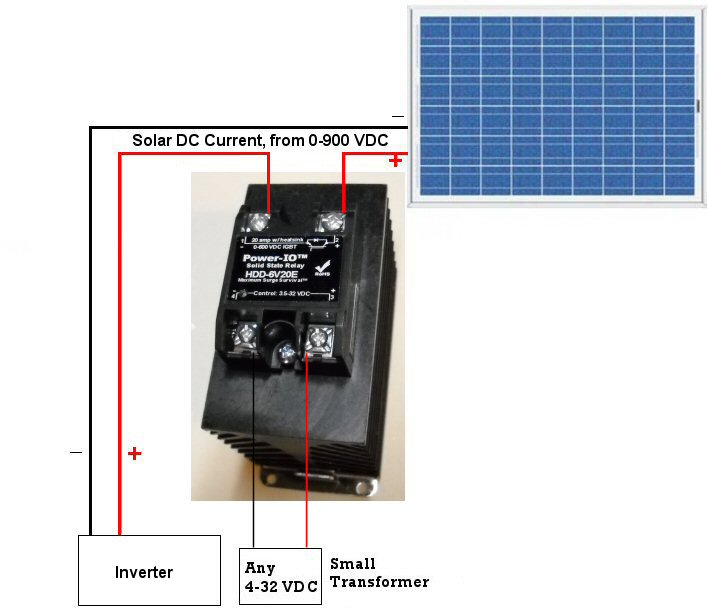
 |
Solar panel disconnect switch, remote activation600 VDC or 900 VDC switch, normally open, "California Solar Panel Disconnect Program"The state of California is active in encouraging residential solar energy. The local fire department districts are coordinating efforts so that a standard can be written for a quick, remote, high voltage DC disconnect. The purpose of this disconnect is to permit the fire personnel to quickly shut down the DC system at the roof, so that all cables, which might be hidden inside interior walls, are safe when fire personnel respond to a fire. Power-io has published this data at: http://www.power-io.com/california. This web page will be updated as statewide requirements are defined and agreed upon. In response to inquiries on 600 VDC, or higher, switching; Power-io manufactures a standard product called an HDD-6V20E or HDD-9V30E that are shown at: http://www.power-io.com/products/hdd.htm. This is a "normally open" solid state relay that can switch any DC voltage up to 600 VDC / 20 amps or 900 VDC / 30 amps. Multiple units can be used, in parallel, in order to double or triple the amperage capability. Power-io can also build customized products, as requested. The complete solution for the California program may involve custom design engineering, which would need to be approved by multiple agencies. How the Power-io product works: The Power-io product requires a control signal between 4 and 32 VDC to turn the product "ON". In your application, that might be provided by a small AC transformer that is similar to what is used with a cell phone. If AC power is removed from that transformer, or if there are other disconnect switches on the control line, then the Power-io product will turn "OFF". For example: if the fire department "pulls the meter", the transformer turns OFF and the Power-io disconnect switch goes open. The transformer, the invertor, the batteries are located in an interior location such as the garage. The Power-io unit is located near the solar panels such as roof top, attic, etc. The Power-io unit is installed in a weather protected environment. The Power-io generates a small amount of heat, when ON, so it needs to be installed on a heat sink. The control signal wires are low voltage wiring, similar to what is installed for thermostats, telephones, or garage door openers. The final fire department code might prefer to have two Power-io units, in series, to ensure a higher level of safety that the circuit has been opened. The existing Power-io units may have a 0.5mA leakage, due to the nature of the solid state design. |
 |
|
The Power-io unit needs a heat sink to dissipate any heat. This is similar to how a Pentium™ computer chip works. An appropriate heatsink might be our HEATSK-DIN-1.0 http://www.power-io.com/products/heatsinks.htm. If multiple units are used, they are wired as shown on our web site http://www.power-io.com/library/appnotes/dual-mosfet-switching.htm . The Power-io unit in the picture above is approximately 5 x 5 x 2.5 inches, including the heat sink. If several California districts agree upon a standard, Power-io could provide a complete package that includes a weather-proof enclosure, the Power-io solid state relay, heat sink, etc. The data bulletin for the product is at: http://www.power-io.com/library/databulletin/hdd-e-family.pdf If we can assist with any questions, please contact Power-io at your convenience. Tel: 1 630 717 7335 |